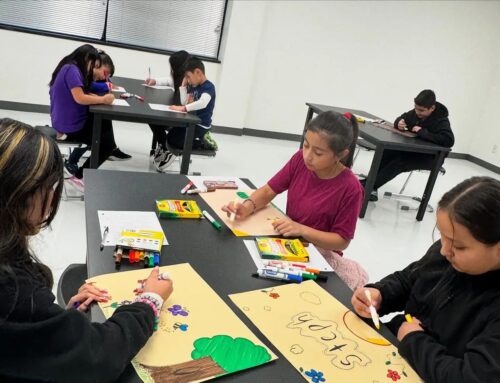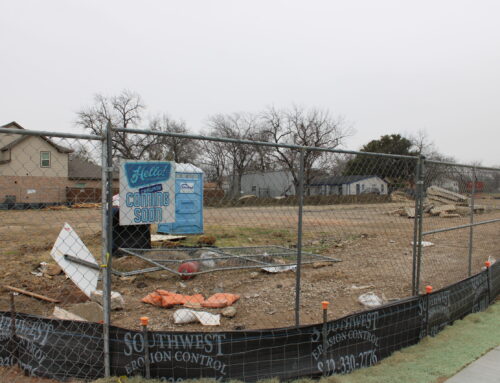City of Dallas fails to protect character of La Bajada neighborhood
“Progress through pain” is how activist Maria Lozada Garcia describes the process of protecting her native West Dallas neighborhood, La Bajada. Over the last year, Garcia has watched as large two-plus story homes have come into the historic Latino barrio, despite a zoning law neighbors worked to put into place more than 10 years ago.
“My father and residents of La Bajada fought to implement the neighborhood stabilization overlay to protect our neighborhood of essential workers,” Garcia told the City of Dallas Board of Adjustment during a July meeting. “Please explain how this exorbitant monstrosity of a house is compatible with modest working-class homes in La Bajada.”
In 2005 the City of Dallas formed NSOs, or Neighborhood Stabilization Overlays, to allow residents to create guidelines for yards, garages and building heights. Citywide, there are now 14 active NSOs.
The NSO ordinance paved the way for Dallas residents to protect their neighborhoods from a “teardown trend” — when real estate developers tear down an existing home and build a much larger one in its place, often as tall and as close to the edges of the property as Dallas building codes allow. Maximizing a lot allows developers to maximize their profit from a home’s sale.
La Bajada’s NSO restricts the height of a house to no more than 27 feet. Garcia, daughter of the late community activist Felix Lozada Sr., said the intention of the restriction was to preserve the community’s character and to stabilize property values.
La Bajada is the easternmost West Dallas neighborhood, adjacent to the Trinity River and the Margaret Hunt Hill Bridge, which was completed in 2012 to connect West Dallas and Downtown. La Bajada finalized its NSO the same year, as residents watched swift redevelopment of their neighborhood and anticipated more developers would suddenly value their historically devalued community. They feared this could drive up property values for everyone and leave longtime homeowners unable to pay the rising property taxes.
Longtime homes in La Bajada are around a thousand square feet and are valued at around $200,000, according to Zillow reports and the Dallas County Appraisal District’s website. In 2012, these same homes appraised for between $25,000 and $40,000.
Conversely, new homes often comprise more than 3,500 square feet and can sell for almost a million dollars.
Garcia believes the city’s lack of enforcement shows disregard toward the historically working-class community.
“Approving the variance in height and allowing them to build higher states that the Board of Adjustment and the City of Dallas does not care about the stress and hardship that the residents endured to obtain the NSO,” Garcia said at the meeting. “Approval states that the City of Dallas values money and wealth over equity and equality.”
Garcia and other La Bajada residents spent their afternoon asking why the 2012 zoning ordinance was not being enforced.
The City of Dallas does allow residents and developers to appeal for zoning exemptions if they can show “hardship” circumstances, such a restrictive lot with an irregular shape or slope, or can make a case that the variance will not adversely impact the surrounding community. Appeals are reviewed by city employees in transportation engineering, public works, planning and other relevant departments, and final decisions are made by the Board of Adjustment, composed of City Council-appointed volunteers who represent the “geographical and ethnic diversity” of the city.
La Bajada residents have expressed frustration that the height and size of several new homes in their neighborhood are incompatible, but the July 18 Board of Adjustment meeting focused on just one house being constructed at 3349 Coronet Avenue. The city’s building permit backlog has made headlines in recent months, and some projects were contracted out to third-party vendors. One of those vendors issued a building permit for 3349 Coronet in January, despite the construction plan’s overstepping of height restrictions in the La Bajada NSO and even City of Dallas building codes.
Owner Lance Thames received a notice from the City in May revealing that the height of his building was not properly approved. Thames, who has lived nearby on Canada Drive for the past two years, requested an appeal, citing an elevator shaft and mechanical equipment as justification for the extended height.
“This is my husband and I’s forever home,” Thames said. “It’s our dream home. We’re both going to retire in the next five years.”
Thames’ attorney, former Dallas City Council member Philip Kingston, argued that the Board of Adjustment should approve his client’s appeal, given that the home endured damages from the construction delay, and the owner had already made a significant investment in the home.
“We’ve been sitting for about two months with a lot of rain, and [the house] is deteriorating,” Kingston said. “My clients already have about $350,000 in construction draws, they’re clipping along at about 8%, so there’s some urgency here … to fix it, we estimate that that’s going to be $400,000.”
Board of Adjustment chairman David Neumann, another former city councilman, said the city needs to take these mistakes seriously because they come at a cost to the city, property owners, and neighborhoods.
“These types of mistakes are more costly than just the dollars and the time they create; they create an erosion of public trust in our city,” Neumann said. “Part of what I’ve advocated for this Board of Adjustment with the executive staff of the city is, we gotta do better. Too many mistakes are being made and this impacts a property owner and a neighborhood. We gotta do better than this.”
Neumann sympathized with the homeowner, particularly because the city issued the permit in error.
“I hate to penalize a property owner who was trying to follow the rules and had stopped when they were told to stop,” Neumann said.
La Bajada property owner Sylvia Lagos blamed city staff for not understanding the ordinance requirements and her community’s character. She pointed out that if the board approves the appeal, it could open the door for other height variances to be approved.
“The planning staff’s lack of knowledge is not my problem. That’s a city problem, and the city needs to rectify that problem,” Lagos told the Board of Adjustment. “Not following the NSO, it sets a precedent for other builders to follow, it increases our property taxes even more. It destroys the character of the neighborhood.”
When appeals are made, the city is required to notify property owners within a 200-foot radius. La Bajada resident Tony Carrillo, who ran for Dallas City Council against Councilman Omar Narvaez earlier this year, says this process excludes people who live outside of the radius but are still affected by newer, taller and larger homes.
“One of the main reasons we implemented the NSO and the height restriction was because we wanted to make sure … to keep low-income families in [our neighborhood],” Carrillo said. “In the City of Dallas, we don’t have enough housing for our lower income families, and this is going to affect that issue also.”
Residents outside of the 200-foot radius are able to submit letters of support or opposition. City staff presented 16 letters submitted in favor of Thames’ appeal, and many letters of opposition were received, including a petition opposing the appeal with nine pages of signatures submitted by fourth-generation La Bajada resident John Gallegos.

Gallegos cited the West Dallas Urban Structure & Guidelines Area Plan, which was adopted by the city in 2011 to both conserve and revitalize neighborhoods such as La Bajada. He and other neighbors believe this issue extends further than just the height of one home, and is an example of a larger trend in the neighborhood of builders finding ways around the NSO’s restrictions.
“Our community has dedicated significant effort toward improving our neighborhood, only to have individuals find and exploit such loopholes to build homes, with the added disappointment of city employees approving them,” Gallegos told the board. “We not only hope to see the rejection of this application, but also demand to see action by our city leaders and departments.”


Alberto Salinas, La Bajada association president, says he and his neighbors have reached out to the city through multiple offices asking for further enforcement of the NSO. What’s clear to neighbors, when they compare the new homes being built to their existing ones, is that the intent of the La Bajada NSO is not being honored.
“Please take a harder look at what we’re trying to do here, we’re trying to preserve the community and its structure for our next generations,” Salinas said. “I welcome people from all areas, from all walks of life to come to our neighborhood, but keep the rules and guidelines that the City of Dallas has given us to follow, and not continue to modify or adjust its meaning.”
The board voted 4-1 to postpone a decision until the Tuesday, Aug. 15 meeting, with a briefing at 10:30 a.m, followed by a public hearing at 1 p.m. Interested neighbors can join the meeting virtually, and pre-register to speak remotely, or attend in person at City Hall in RM 6EN and register on-site.
Share This Story, Choose Your Platform!
Michaela Rush joined Dallas Free Press in July 2023, as a Report for America Corps Member. Prior to joining RFA and DFP, Michaela worked at The Battalion student newspaper at Texas A&M, most recently as the editor-in-chief, covering campus news, local businesses, student organizations and LGBTQ+ topics. Outside of journalism, she plays several instruments, including flute and alto saxophone, and is a self-proclaimed “band nerd.”
Official Title:
Report for America Corps Member
Email Address:
michaela@dallasfreepress.com









La Bajada is Elm Thicket North Park. We are all deeply affected by the decisions made by the Dallas Board of Adjustments, particularly with a Chairman who, as a former council member, has proven to be untrustworthy.
No government body should hold unchecked power, and we strongly believe that oversight and accountability are essential for the well-being of our communities.